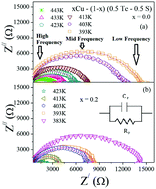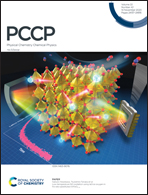Transport phenomena of Cu–S–Te chalcogenide nanocomposites: frequency response and AC conductivity
Abstract
In this work, the development and electrical characterization of several chalcogenide nanocomposites have been reported. X-ray diffraction (XRD) has been used to reveal their microstructures. Mott's variable range hopping model has been used to interpret the DC conductivity data of the nanocomposites at lower temperatures. The DC conductivity data at higher temperatures has been explained well using Greave's model. To explain the AC conductivity data, the Meyer–Neldel (MN) conduction rule has been employed. The AC conductivity spectra at different temperatures have been analyzed using Almond–West formalism. Different conduction models, namely, correlated barrier hopping (CBH) and modified non-overlapping small polaron tunneling (NSPT), have been used to interpret the conduction mechanism of the nanocomposites. Scaling of the AC conductivity spectra reveals that the electrical relaxation process is independent of temperature, but depends on the nanocomposite composition. The conductivity mechanism is explained using a schematic structural model.



 Please wait while we load your content...
Please wait while we load your content...